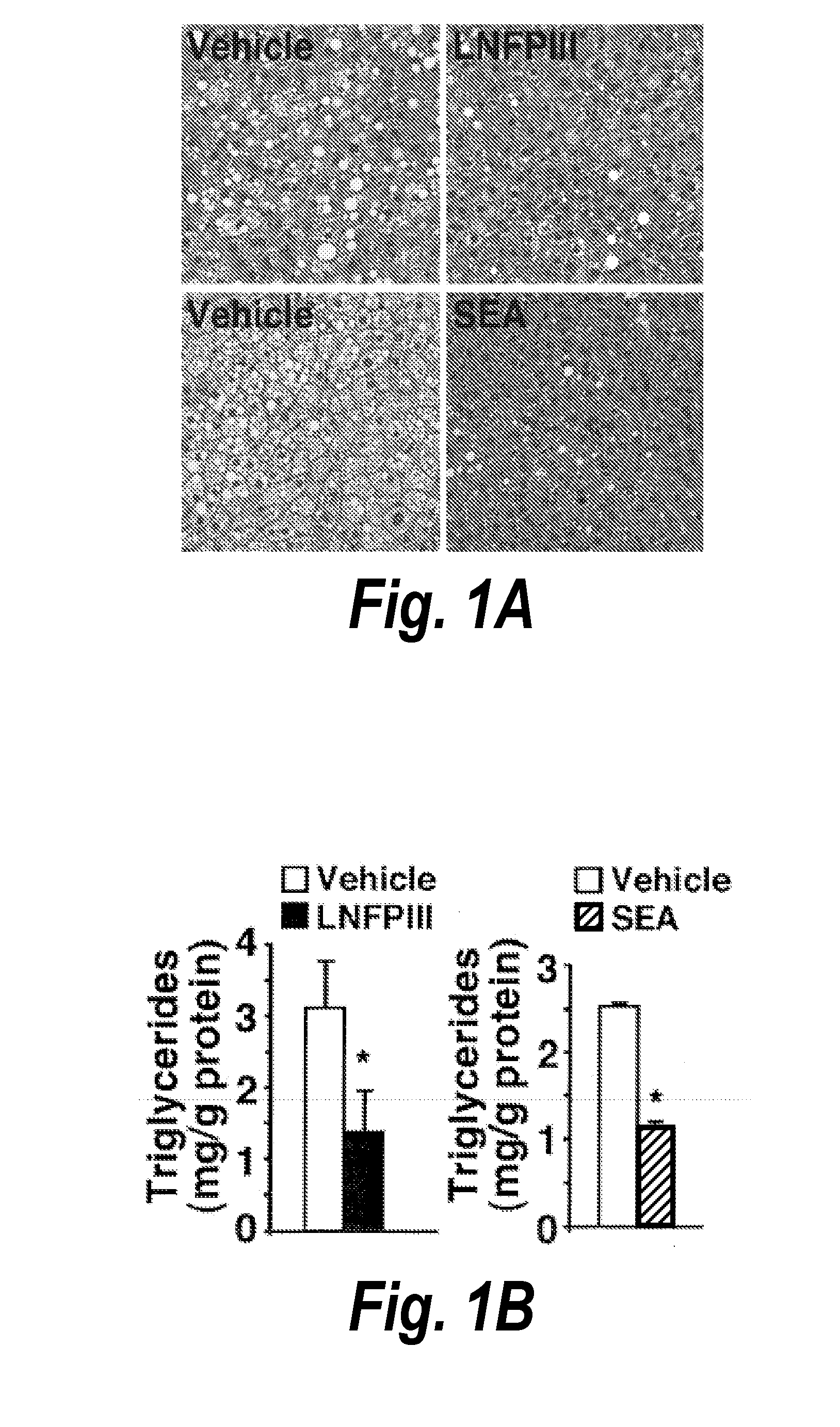Methods of treating fatty liver disease with helminth-derived glycan-containing compounds
- Summary
- Abstract
- Description
- Claims
- Application Information
AI Technical Summary
Benefits of technology
Problems solved by technology
Method used
Image
Examples
example 1
Treatment of High Fat Diet-Induced Steatosis and Preservation of Liver Function by LNFPIII
[0149]In this example, the ability of LNFPIII or SEA to prevent high fat diet-induced steatosis and preserve liver function was examined. Mice were injected with either vehicle (dextran, 25 μg), LNFPIII conjugated to dextran (25 μg), or SEA twice a week (n=5 for each group) as described in the Methods section. Histological assessment revealed less high fat diet-induced hepatic lipid accumulation in livers of LNFPIII- or SEA-treated mice compared to vehicle-treated mice (FIG. 1a). Furthermore, there were significantly lower levels of triglycerides in livers of LNFP- or SEA-treated mice compared to vehicle treated mice (*pb). Similar results are expected with other animal models of FLD including, e.g., virus-induced FLD (e.g., HIV or hepatitis virus-induced).
[0150]To determine whether the decreased lipid accumulation and lower triglyceride levels in the liver could be attributed to differences in...
example 2
LNFP III-Mediated Suppression of Lipogenesis Through FXRα Activation in the Liver
[0154]Based on the reduced lipogenic gene expression profile seen in the liver (see Example 1), the ability of LNFP III to suppress lipogenesis was assessed. To this end, primary mouse hepatocytes were isolated and subjected to de novo lipogenesis assays upon treatment with LNFP III (20 μg / ml) or vehicle (dextran). LNFPIII significantly suppressed lipogenesis and increased fatty acid β-oxidation in hepatocytes compared to vehicle treated cells (*pa). Given that LNFP III treatment did not affect β-oxidation gene expression (FIGS. 1c and 2b), the increased fat burning was likely secondary to decreased fatty acid synthesis.
[0155]In order to gain mechanistic insight into how LNFPIII was suppressing lipogenesis, SREBP-1c was focused on given its role as a master lipogenic transcription factor and its downregulation in liver tissue of mice treated with LNFPIII (FIG. 1c). SREBP-1c expression and transcriptiona...
example 3
Signaling Pathways that Link LNFPIII and FXRα
[0158]Both human and mouse FXRα contain two major promoters (FIG. 2c). FIG. 2c shows the genomic structure showing alternative promoter usage to drive the expression of human FXRα1 / α2 (promoter 1) and FXRα3 / α4 (promoter 2). Sequence comparison reveals high conservation in the 5′ regulatory sequences between mouse, rat, and human FXRα genes (FIG. 3a). To examine the signalling pathways through which LNFPIII regulates FXRα activity, the activities of luciferase reporters driven by upstream (promoter 1) or downstream (promoter 2) regulatory regions were examined in HepG2 cells (human hepatoma cells). Reporters driven by a 2 kb fragment of human FXRα promoter 1 or a 0.13 kb fragment of human FXRα promoter 2 were transfected into HepG2 cells. Twenty-four hours after transfection, cells were treated with or without LNFPIII (20 μg / ml) or SEA (2 μg / ml) for an additional 24 hours. When HepG2 cells were transfected with promoter 1- or promoter 2-lu...
PUM
| Property | Measurement | Unit |
|---|---|---|
| Mass | aaaaa | aaaaa |
| Molecular weight | aaaaa | aaaaa |
Abstract
Description
Claims
Application Information
 Login to View More
Login to View More - R&D
- Intellectual Property
- Life Sciences
- Materials
- Tech Scout
- Unparalleled Data Quality
- Higher Quality Content
- 60% Fewer Hallucinations
Browse by: Latest US Patents, China's latest patents, Technical Efficacy Thesaurus, Application Domain, Technology Topic, Popular Technical Reports.
© 2025 PatSnap. All rights reserved.Legal|Privacy policy|Modern Slavery Act Transparency Statement|Sitemap|About US| Contact US: help@patsnap.com



